#Herakleia
Explore tagged Tumblr posts
Text

..
#landscape#mountains#archaeology#hiking#türkiye#original photographers#autumn#original photography#fall#turkey#herakleia#latmos#nature#autumn aesthetic#fall aesthetic#landscape photography#caria#bafa gölü#Muğla#aydın#architecture#antiquity
11 notes
·
View notes
Text


HYDRIA | Described as "Patroclus killing Sarpedon, whose body is carried away by Hypnos and Thanatos" [around the neck]. Body : Amazonomachy [Patroclus and Two Amazons]. Proto-Lucanian Red-figured Hydria attributed to the Policoro Painter End of the 5th c. BC [From Herakleia Tomb I. also known as "Tomb of the Policoro Painter"]
[Loan to] Baths of Diocletian, Museo Nazionale Romano | MNR BOD [Ground Floor Hall II. "The Eternal Fame of Heroes" Exhibition, June 2023] From Museo Archeologico Nazionale della Siritide or "Policoro Museum": • Web : https://museosiritide.beniculturali.it • IG : @museonazionaleromano @museibasilicata
MNR BOD MANSiritide | Michael Svetbird phs©msp | 18|06|23 6000X4300 600 The photographed object is the collection item of MAN Siritide & MNR and subject to copyrights. [non commercial use | sorry for the watermarks]
#rome#bathsofdiocletian#termedidiocleziano#museonazionaleromano#siritide#archaeological museum#herakleia#policoro#painter#hydria#vasepainting#ancient pottery#red figure pottery#lucania#pottery#arthistory#antiquity#antiquities#archaeology#ancient#museology#greekmythology#ancientart#patroclus#amazonomachy#amazons#amazzoni#archaeologyphotography#museum photography#michaelsvetbird
17 notes
·
View notes
Text

x
#Iraklia#Herakleia#Heraklia#beach#mediterranean#Гераклия#Ηράκλεια#طبيعة#شاطئ#bãi biển#sahil#παραλία#greece
2 notes
·
View notes
Text
Kretisches Kaffeetagebuch: Iraklio I - Agios Minas
Der Name dieser Metropole kommt nicht von Ungefähr: Iraklio bezieht sich auf den griechischen Halbgott Herakles, der hier an Land gegangen sein soll auf der Jagd nach dem Kretischen Stier, die siebte Aufgabe, die Eurystheos dem Helden gestellt hatte. Der Stier ist uns schon in Knossos begegnet. Minos verhalf der Besitz dieses schönen Tieren zur Königswürde, doch er behielt ihn anschließend…

View On WordPress
#coffeenewstom#Agios Minas#Agios Titos#Athanasios Moussis#Byzantinisches Reich#Byzanz#Candia#Cappuccino frappé#Cappuccino freddo#Cappucciono freddo#Chandakas#Chandax#Coffeenewstom#Daidalos#Dädalus#Eurysteus#Eurystheos#Frappé#Frappe#Freddo#Freddo Cappuccino#Freddo Espresso#Gortyn#Hadaq#Herakleia#Herakles#Heraklion#Herkules#Hodegentia#Iraklio
1 note
·
View note
Note
Professor, speaking of the statuary group of Krateros… I was wondering why he was celebrated for saving Alexander’s life during the hunt, while Lysimachos was punished by Alexander and locked in a cage with the lion. Surely, the latter must be an exaggeration 😂, but it does make me think. Sorry for the stupid question!
Lysimachos of Thessaly (then Thrace)
So, Lysimachos was supposedly locked in with a lion because he got poison to Kallisthenes, after Alexander had condemned him to be carried around in a cage. Justin tells us about it (15.3-10), as does Pausanias (1.9.5), albeit more briefly. Curtius has the real story (8.1.13-17). Lysimachos was among the king’s Companions during a hunt in Baktria, where he tried to protect Alexander from a lion, but the king ordered him to step aside and killed the beast himself. He reminded Lysimachos of a time in Syria when he’d been badly mauled by a really BIG lion, and Alexander didn’t want a repeat. (He also wanted show he was king and didn’t need “protecting”!)
Lysimachos was a Bodyguard (Somatophylax) of the king, perhaps from early on, depending on his age. He was Thessalian by ancestry, but his father had been important at Philip’s court, as an Hetairos, so he was probably raised in Pella. He had several brothers who also held important positions in the army. In the novels, I have him as a contemporary of Alexander as part of my “let’s reduce the number of names floating around in the series,” but he was probably a little bit older by 4-6 years. He was much too important for the king to get away with throwing to a lion. Haha. Certainly not for anything less than treason.
Later, after Alexander’s death, he was allied with Kassandros, as he’d married his sister Nikaia, before Antipatros’s death. In the 323 divisions after ATG’s death, he was assigned the satrapy of Thrace, which he eventually became king of probably in the very late 300s. Another oddity, in 302, he married Amastris, who’d been the widow of Dionysos of Herakleia…but before that, she was the highborn princess given to Krateros at the Susa Marriages. Krateros divorced her (apparently with her blessing) in order to marry Phila, who was Nichaia’s (older?) sister. She then married Dionysos. Lysimachos died in 282/1.
(Also, btw, the statue group of Krateros and Alexander was made long after Alexander was dead. And Krateros was dead.)
#asks#Lysimachos#Alexander the Great#Lysimachus#lion hunting with Alexander#Classics#ancient Macedonia#ancient Greece
10 notes
·
View notes
Text
"There is one clear early Hellenistic example of a regnant basilissa: Amastris, who ruled Herakleia Pontika after the death of her husband, its tyrant Dionysios. She eponymously founded the neighboring city of Amastris c. 300 BCE, and from there issued coins bearing the legend “of basilissa Amastris" (ΑΜΑΣΤΡΙΟΣ ΒΑΣΙΛΙΣΣΗΣ). Like many other women ruling as monarchs, Amastris came into direct power because her husband had died and her sons were under age. She brought her own royal credentials to the situation, however, as a niece of Dareios III (daughter of his brother Oxyathres). Like Apama, Alexander had married her to one of his generals (Krateros). After 323 Krateros swapped her for Phila, and she moved to Herakleia to live with Dionysios, who, as Memnon tells us later (probably after 306), began to call himself basileus. Although supervising the regency for her sons, Amastris faced interventions by Antigonos Monophthalmos, ostensibly on the children’s behalf, to control Herakleia, and then by Lysimachos, who also married her. By 300 she was solo again with no outside interference, and her foundation of Amastris marks the point when she fully embraced the role of a regnant basilissa. Although her sons soon came of age, she maintained this role until they assassinated her c. 284."
— Gillian Ramsey, "Apama and Stratonike," The Routledge Companion to Women and Monarchy in the Ancient Mediterranean World (Edited by Elizabeth D. Carney and Sabine Müller)
17 notes
·
View notes
Text
GREEK HOLIDAYS
Here is a list of Greek Holidays, updated as often as I can and as I research.
Anthesteria
Lenaia
Dionysia
Thargelia
Arrephoria
Kronia
Aphrodisia
Panathanaia
Herakleia
Genesia
Pyanepsia
Thesmophoria
Khalkeia
Rural Dionysia
Haloa
Elaphebolia
City Dionysia
SOURCE 1, 2, 3,
| GOOGLE CALENDAR |
11 notes
·
View notes
Text
Saints&Reading: Friday, June 21, 2024
june 8_June 21
SAINT EPHREM, PATRIARCH OF ANTIOCH (546)

Saint Ephraim, Patriarch of Antioch, a Syrian, was a military general under the emperors Anastasius (491-518) and Justin (518-527). The saint was distinguished for his virtue, piety, and compassion for all the destitute.
In the year 526 the Lord punished Antioch for Christians falling into the heresies of Nestorius and Eutyches: an earthquake destroyed this magnificent city. A large number of the inhabitants perished. Patriarch Euphrasios was crushed beneath a fallen column.
The emperor summoned Ephraim to oversee the restoration of the ruined city. Among the workers was a bishop who left his see for unknown reasons. He predicted to Ephraim his election to the patriarchal throne and asked him not to abandon deeds of charity, and to struggle firmly against the heretics. In the year 527 Ephraim was indeed elected to the patriarchal throne. He governed his flock firmly and wisely by the example of his life. He also defended it against heretical teachings through his sermons and letters.
The following event gives some idea of his faith. Near Herakleia was a stylite practicing asceticism, who had fallen into heresy. Learning about the ascetic, Ephraim went to him and urged him to be reunited to the Orthodox Church. The stylite was not agreeable. He decided to frighten the patriarch and he offered to kindle a large bonfire, so that they both might enter the fire. The bonfire was set, but the stylite did not dare to go into it. The patriarch prayed to the Lord Jesus Christ to show that his was the correct faith and, removing his omophorion, he put it in the bonfire. After three hours the firewood was consumed, but the omophorion of the saint was taken out unharmed. The stylite was converted from his heresy and reunited to the Church.
Ephraim fell asleep in the Lord in the year 545 AD.
Among his labors, Ephraim defended the teaching of the Orthodox Church on the union of two natures, the divine and the human, in the Person of our Lord Jesus Christ.
THE MONK ZOSIMA OF PHOENICIA (6th.c.)

On June 21, we honour Saint Zosimas, monk, of Phoenicia (Syria).
St Zosimus of Phoenicia was born in Syria, in the village of Synda, near the city of Tyre.
He took monastic vows and engaged in ascetic labours, cultivating in himself Christian virtues.
For his zeal in fasting and prayer, God bestowed on His saint the gift of clairvoyance. Thus St Zosimus foretold the earthquake which destroyed Antioch in the year 526.
Once, the patrician Arkesilaus visited the saint. During their conversation a messenger arrived to inform Arkesilaus that his wife had punctured her eye with a needle and was suffering great pain. But St Zosimus reassured his guest saying that the holy Bishop John the Chozebite would heal his wife. And so it happened.
St Zosimus attained such a degree of spiritual accomplishment that wild beasts were submissive to him. Once when the saint was on the way to Caesarea, a lion killed and ate his donkey.
The saint found the beast and said, “Friend, I have not the strength to carry the load because of old age. You carry it, and then return into the wilderness and again be fierce according to your nature.” The lion obediently carried the load to Caesarea, and then the saint let him go.
Source: @stelizabethconvent.orthodox on Instagram


ACTS 27:1-44
1 And when it was decided that we should sail to Italy, they delivered Paul and some other prisoners to one named Julius, a centurion of the Augustan Regiment. 2 So, entering a ship of Adramyttium, we put to sea, meaning to sail along the coasts of Asia. Aristarchus, a Macedonian of Thessalonica, was with us.
3 And the next day we landed at Sidon. And Julius treated Paul kindly and gave him liberty to go to his friends and receive care. 4 When we had put to sea from there, we sailed under the shelter of Cyprus, because the winds were contrary.
5 And when we had sailed over the sea which is off Cilicia and Pamphylia, we came to Myra, a city of Lycia. 6 There the centurion found an Alexandrian ship sailing to Italy, and he put us on board.
7 When we had sailed slowly many days, and arrived with difficulty off Cnidus, the wind not permitting us to proceed, we sailed under the shelter of Crete off Salmone. 8 Passing it with difficulty, we came to a place called Fair Havens, near the city of Lasea.
9 Now when much time had been spent, and sailing was now dangerous because the Fast was already over, Paul advised them, 10 saying, "Men, I perceive that this voyage will end with disaster and much loss, not only of the cargo and ship, but also our lives."
11 Nevertheless the centurion was more persuaded by the helmsman and the owner of the ship than by the things spoken by Paul. 12 And because the harbor was not suitable to winter in, the majority advised to set sail from there also, if by any means they could reach Phoenix, a harbor of Crete opening toward the southwest and northwest, and winter there.
13 When the south wind blew softly, supposing that they had obtained their desire, putting out to sea, they sailed close by Crete. 14 But not long after, a tempestuous head wind arose, called Euroclydon.
15 So when the ship was caught, and could not head into the wind, we let her drive. 16 And running under the shelter of an island called Clauda, we secured the skiff with difficulty. 17 When they had taken it on board, they used cables to undergird the ship; and fearing lest they should run aground on the Syrtis Sands, they struck sail and so were driven.
18 And because we were exceedingly tempest-tossed, the next day they lightened the ship. 19 On the third day we threw the ship's tackle overboard with our own hands.
20 Now when neither sun nor stars appeared for many days, and no small tempest beat on us, all hope that we would be saved was finally given up. 21 But after long abstinence from food, then Paul stood in the midst of them and said, "Men, you should have listened to me, and not have sailed from Crete and incurred this disaster and loss.
22 And now I urge you to take heart, for there will be no loss of life among you, but only of the ship. 23 For there stood by me this night an angel of the God to whom I belong and whom I serve,
24 saying, 'Do not be afraid, Paul; you must be brought before Caesar; and indeed God has granted you all those who sail with you.' 25 Therefore take heart, men, for I believe God that it will be just as it was told me.
26 However, we must run aground on a certain island. 27 Now when the fourteenth night had come, as we were driven up and down in the Adriatic Sea, about midnight the sailors sensed that they were drawing near some land.
28 And they took soundings and found it to be twenty fathoms; and when they had gone a little farther, they took soundings again and found it to be fifteen fathoms. 29 Then, fearing lest we should run aground on the rocks, they dropped four anchors from the stern, and prayed for day to come.
30 And as the sailors were seeking to escape from the ship, when they had let down the skiff into the sea, under pretense of putting out anchors from the prow, 31 Paul said to the centurion and the soldiers, "Unless these men stay in the ship, you cannot be saved."
32 Then the soldiers cut away the ropes of the skiff and let it fall off. 33 And as day was about to dawn, Paul implored them all to take food, saying, "Today is the fourteenth day you have waited and continued without food, and eaten nothing.
34 Therefore I urge you to take nourishment, for this is for your survival, since not a hair will fall from the head of any of you. 35 And when he had said these things, he took bread and gave thanks to God in the presence of them all; and when he had broken it he began to eat.
36 Then they were all encouraged, and also took food themselves. 37 And in all we were two hundred and seventy-six persons on the ship.
38 So when they had eaten enough, they lightened the ship and threw out the wheat into the sea. 39 When it was day, they did not recognize the land; but they observed a bay with a beach, onto which they planned to run the ship if possible.
40 And they let go the anchors and left them in the sea, meanwhile loosing the rudder ropes; and they hoisted the mainsail to the wind and made for shore. 41 But striking a place where two seas met, they ran the ship aground; and the prow stuck fast and remained immovable, but the stern was being broken up by the violence of the waves.
42 And the soldiers' plan was to kill the prisoners, lest any of them should swim away and escape. 43 But the centurion, wanting to save Paul, kept them from their purpose, and commanded that those who could swim should jump overboard first and get to land, 44 and the rest, some on boards and some on parts of the ship. And so it was that they all escaped safely to land.
JOHN 17:18-26
18 As You sent Me into the world, I also have sent them into the world. 19 And for their sakes I sanctify Myself, that they also may be sanctified by the truth. 20 I do not pray for these alone, but also for those who will believe in Me through their word; 21 that they all may be one, as You, Father, are in Me, and I in You; that they also may be one in Us, that the world may believe that You sent Me. 22 And the glory which You gave Me I have given them, that they may be one just as We are one: 23 I in them, and You in Me; that they may be made perfect in one, and that the world may know that You have sent Me, and have loved them as You have loved Me. 24 Father, I desire that they also whom You gave Me may be with Me where I am, that they may behold My glory which You have given Me; for You loved Me before the foundation of the world. 25 O righteous Father! The world has not known You, but I have known You; and these have known that You sent Me. 26 And I have declared to them Your name, and will declare it, that the love with which You loved Me may be in them, and I in them.
#orthodoxy#orthodoxchristianity#easternorthodoxchurch#originofchristianity#spirituality#holyscriptures#wisdom#gospel#bible#faith#saints
3 notes
·
View notes
Text

The three festivals which I've placed in the Thasian month of Thargelion (which is out of sync with the Athenian calendar for now, things will line up again next month.)
The Great Herakleia and the Choreia are both atttested in the festival list provided by inscription SEG xix 415 as festivals for which legal business was not permitted at the end of the 4th century on the island. Herakles was the city's patron deity alongside Dionysus, so it is not surprising for their respective festivals to be considered as important.
I celebrate the Herakleia on the 4-5th. Historically, Herakles received the sacrifice of an ox was worshipped under the epithet of Kallinikos (fair victor). I have kept the epithet and offer beef-based foods.
The Thargelia is an personal addition based on the fact that the month of Thargelion is attested for Thasos. There is solid ground to assume that the Thargelia was celebrated on the island, mainly from the fact that this is one of the most widespread festivals in the Greek world, including in Thasos' mother city, Paros. It is not an exact copy of the Athenian version, but I have kept the main elements. I celebrate it on the 6th-7th for Artemis and Apollo, with an emphasis on the Delian (Delia, Delos) epithets, due to Thasos' heritage of cycladic influence. I have kept the staple offering of panspermia, which I make using figs, seasonal fruits, milk and oat flakes.
And the final festival for the month is the Choreia for Dionysus, which is not well known and attested nowhere outside of Thasos, except for Dionysus' epithet Choreios which Plutarch claims is from the island of Paros, Thasos' mother city. The festival is assumed to have involved dancing, singing or theatrical contests, but we do not have enough information about it to know. I celebrate it on the 12th-15th of the month and typically offer beef and fennel, as well as wine. This year I served it in a samoon bread because I felt like it (it pairs wonderfully).
Keep in mind that my personal practice is both very speculative and locally-focused. I share details of my practice only for the sake of sharing the methodology behind what I do and doesn't mean that my way of doing things is the only possible way.
#thasian recon#personal practice#my intercalary month is starting at the next new moon and it's going to be a welcome break#having 3 festivals so close from one another is ooof
27 notes
·
View notes
Text
My calendar, translated to our modern calendar for ease.
January:
• Not included. Started my translation in February.
February:
• 1st - Imbolc
• 3rd-6rd - Lenaia
• 11th - Libation to Aphrodite
• 14th - Valentine’s Day
• 18th - Theogamia
• 20th - Hekate’s Deipnon
• 21st - Noumenia
• 22nd - Agathos Daimon
• 23rd - Veles and Lucifer’s Day of Worship
• 24th - Aphrodite, Hermes, Loki, and Freyja’s Day of Worship
• 25th - Dionysus and Prince Seere’s Day of Worship
• 26th - Ares’ Day of Worship
• 27th - Apollon’s Day of Worship
• 28th - Melinoe and Hades’ Day of Worship
March:
• 1st - Zeus, Hera, and Egeria’s Day of Worship
• 3rd-5th - Anthestaria
• 11th - Libation to Hephaistos
• 15th - Diasia
• 17th - St. Patrick’s Day
• 21st - Ostara
• 22nd - Hekate’s Deipnon
• 23rd - Noumenia
• 24th - Agathos Daimon
• 25th - Veles and Lucifer’s Day of Worship
• 26th - Aphrodite, Hermes, Loki, and Freyja’s Day of Worship
• 27th - Dionysus and Prince Seere’s Day of Worship
• 28th - Ares’ Day of Worship / Elaphebolia
• 29th - Apollon’s Day of Worship
• 30th - Melinoe and Hades’ Day of Worship / Asklepia
• 31st - Zeus, Hera, and Egeria’s Day of Worship
April:
• 1st-8th - Dionysia ta Astika
• 8th - Pandia / Libation to Artemis
• 9th - Easter
• 20th - Hekate’s Deipnon
• 21st - Noumenia
• 22nd - Agathos Daimon / Earth Day
• 23rd - Veles and Lucifer’s Day of Worship
• 24th - Aphrodite, Hermes, Loki, and Freyja’s Day of Worship
• 25th - Dionysus and Prince Seere’s Day of Worship
• 26th - Ares’ Day of Worship / Delphinia
• 27th - Apollon’s Day of Worship
• 28th - Melinoe and Hades’ Day of Worship
• 29th - Zeus, Hera, and Egeria’s Day of Worship
May:
• 1st - Beltane
• 5th - Cinco de Mayo
• 6th - Mounykhia
• 9th - Olympeia
• 13th - Libation to Apollon
• 20th - Hekate’s Deipnon
• 21st - Noumenia
• 22nd - Agathos Daimon
• 23rd - Veles and Lucifer’s Day of Worship
• 24th - Aphrodite, Hermes, Loki, and Freyja’s Day of Worship
• 25th - Dionysus and Prince Seere’s Day of Worship
• 26th - Ares’ Day of Worship / Thargelia
• 27th - Apollon’s Day of Worship / Thargelia
• 28th - Melinoe and Hades’ Day of Worship
• 29th - Zeus, Hera, and Egeria’s Day of Worship
June:
• 8th - Bendideia
• 10th - Libation to Zeus
• 14th - Kallynteria
• 15th - Plynteria
• 18th - Hekate’s Deipnon
• 19th - Noumenia
• 20th - Agathos Daimon
• 21st - Veles and Lucifer’s Day of Worship / Arrephobia / Litha
• 22nd - Aphrodite, Hermes, Loki, and Freyja’s Day of Worship
• 23rd - Dionysus and Prince Seere’s Day of Worship
• 24th - Ares’ Day of Worship
• 25th - Apollon’s Day of Worship
• 26th - Melinoe and Hades’ Day of Worship
• 27th - Zeus, Hera, and Egeria’s Day of Worship
• 30th - Skira
July:
• 2nd - Bouphonia and Dipoleia
• 4th - Independence Day
• 8th - Libation to Athena
• 18th - Hekate’s Deipnon
• 19th - Noumenia
• 20th - Agathos Daimon
• 21st - Veles and Lucifer’s Day of Worship
• 22nd - Aphrodite, Hermes, Loki, and Freyja’s Day of Worship
• 23rd - Dionysus and Prince Seere’s Day of Worship
• 24th - Ares’ Day of Worship
• 25th - Apollon’s Day of Worship
• 26th - Melinoe and Hades’ Day of Worship
• 27th - Zeus, Hera, and Egeria’s Day of Worship
• 30th - Kronia
August:
• 1st - Lammas
• 2nd-3rd - Synoikia
• 10th-17th - Panathenaia ta Megala
• 12th - Libation to Hermes
• 17th - Hekate’s Deipnon
• 18th - Noumenia
• 19th - Agathos Daimon / Herakleia
• 20th - Veles and Lucifer’s Day of Worship
• 21st - Aphrodite, Hermes, Loki, and Freyja’s Day of Worship
• 22nd - Dionysus and Prince Seere’s Day of Worship
• 23rd - Ares’ Day of Worship
• 24th - Apollon’s Day of Worship
• 25th - Melinoe and Hades’ Day of Worship
• 26th - Zeus, Hera, and Egeria’s Day of Worship
September:
• 1st-4th - Eleusinia
• 2nd - Other Major Gods’ Day of Worship
• 6th - Hera Telkhinia
• 9th - Demeter and Persephone’s Day of Worship
• 11th - Zeus Epoptes
• 15th - Hekate’s Deipnon
• 16th - Noumenia
• 17th - Agathos Daimon / Niketeria
• 18th - Veles and Lucifer’s Day of Worship
• 19th - Aphrodite, Hermes, Loki, and Freyja’s Day of Worship
• 20th - Dionysus and Prince Seere’s Day of Worship / Genesios
• 21st-22nd - Mabon
• 21st - Ares’ Day of Worship / Artemis Agrotera
• 22nd - Apollon’s Day of Worship
• 23rd - Melinoe and Hades’ Day of Worship
• 24th - Zeus, Hera, and Egeria’s Day of Worship
• 27th - Demokratia
October:
• 2nd - Epidauria
• 7th - Libation to Hades
• 9th - Feast for Native Ancestors (Indigenous Peoples’ Day)
• 12th - Spirits (Nymphs, Spirits of the Home, etc.) Day of Worship
• 14th - Libation to Poseidon
• 15th - Hekate’s Deipnon
• 16th - Noumenia
• 17th - Agathos Daimon
• 18th - Veles and Lucifer’s Day of Worship
• 19th - Aphrodite, Hermes, Loki, and Freyja’s Day of Worship
• 20th - Dionysus and Prince Seere’s Day of Worship
• 21st - Ares’ Day of Worship / Proerosia
• 22nd - Apollon’s Day of Worship / Oskophoria / Pyanepsia
• 23rd - Melinoe and Hades’ Day of Worship / Theseia
• 24th - Zeus, Hera, and Egeria’s Day of Worship
• 26th-28th - Thesmophoria
• 31st - Halloween
• 31st-2nd - Día De Los Muertos
November:
• 31st-2nd - Día De Los Muertos
• 11th - Libation to Ares
• 14th - Hekate’s Deipnon / Khalkeia
• 15th - Noumenia
• 16th - Agathos Daimon
• 17th - Veles and Lucifer’s Day of Worship
• 18th - Aphrodite, Hermes, Loki, and Freyja’s Day of Worship
• 19th - Dionysus and Prince Seere’s Day of Worship
• 20th - Ares’ Day of Worship
• 21st - Apollon’s Day of Worship
• 22nd - Melinoe and Hades’ Day of Worship
• 23rd - Zeus, Hera, and Egeria’s Day of Worship / Thanksgiving
• 24th - Pompaia
December:
• 9th - Libation to Dionysus
• 13th - Hekate’s Deipnon
• 14th - Noumenia
• 15th - Agathos Daimon
• 16th - Veles and Lucifer’s Day of Worship
• 17th - Aphrodite, Hermes, Loki, and Freyja’s Day of Worship
• 18th - Dionysus and Prince Seere’s Day of Worship / Plerosia
• 19th - Ares’ Day of Worship
• 20th - Apollon’s Day of Worship
• 21st-22nd - Heliogenna
• 21st - Melinoe and Hades’ Worship / Poseidea / Yule
• 22nd - Zeus, Hera, and Egeria’s Day of Worship
• 23rd - Rural Dionysia
• 24th - Christmas Eve / Feast of the Seven Fishes
• 25th - Christmas
18 notes
·
View notes
Text



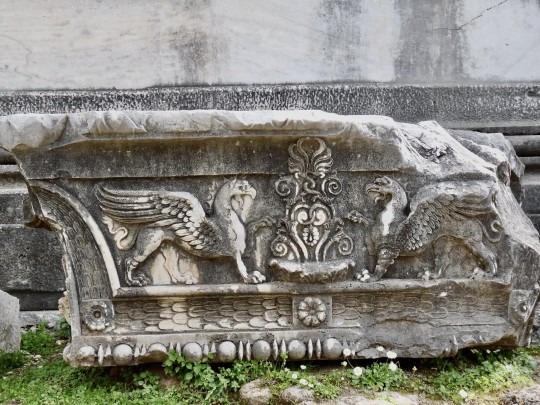
Turkey 2009 (2) (3) (4) by d0gwalker
Via Flickr:
(1) The Temple of Hadrian stands on Curetes Street in the ruined ancient city of Ephesus, near Selçuk in modern day Turkey. (2) (3) Herakleia is a ruined ancient town on the eastern edge of Lake Bafu on the western side of Turkey, by the modern day village Kapıkırı. (4) Fallen lintel stone at Didyma carved with the image of two griffins lies within the central enclosure of the Temple of Apollo.
3 notes
·
View notes
Text
0 notes
Text

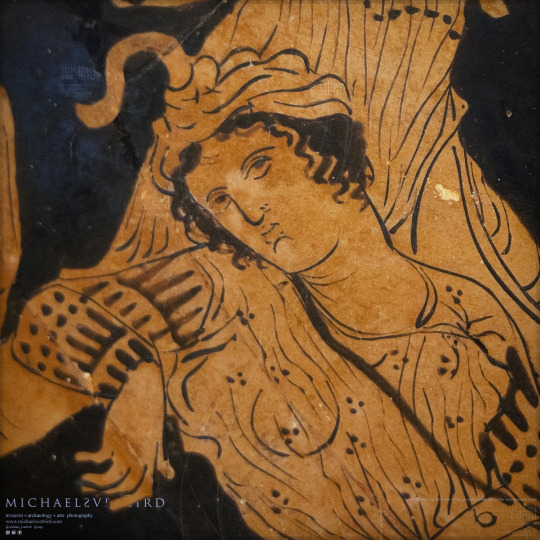
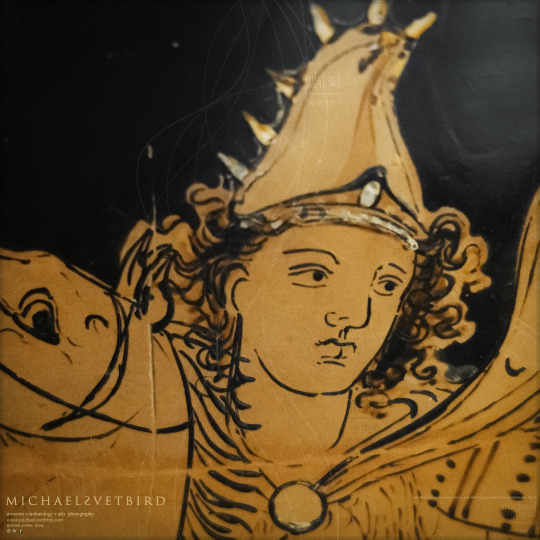
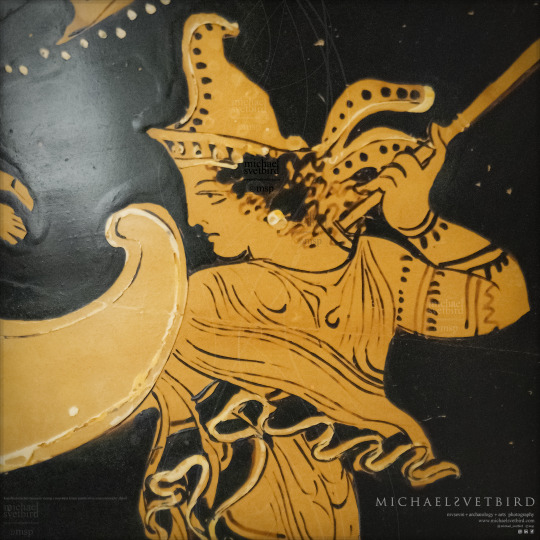

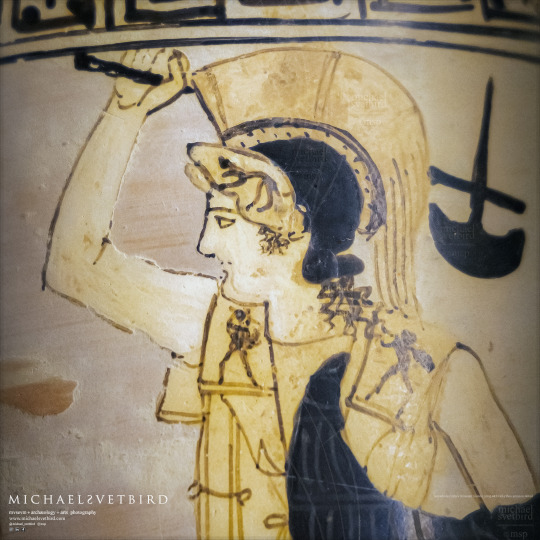

📸 6 NEW PICS [108.-113.] added to the "PORTRAITS OФ AMAZONS" MSP Online Photo-gallery:
👉 D-ART: https://www.deviantart.com/svetbird1234/gallery/67332393/portraits-of-amazons-gallery
👉 FB | Album: https://www.facebook.com/michael.svetbird/media_set?set=a.769989173369662&type=3
📸 Pics 1.-2.:
AMAZON w/ Axe [1.]
PENTHESILEA [2.] Details of proto-Lucanian Red-figured Hydria attributed to the Policoro Painter End of the 5th c. BC [From Herakleia Tomb I. also known as "Tomb of the Policoro Painter"]
Museo Archeologico Nazionale della Siritide or "Policoro Museum", Policoro: • Web : https://museosiritide.beniculturali.it • FB : https://www.facebook.com/DirezioneRegionaleMuseiBasilicata • IG : @museibasilicata [Ph-ed at Baths of Diocletian, Rome] MANS | Michael Svetbird phs©msp 06|23 3000X3000 600 nos.108-109.
📸 Pics 3.-5.:
MOUNTED AMAZON [3.]
AMAZON w/ Spear [4.]
PENTHESILEA [5.] Details of Apulian Red-figured Volute Krater, Side A Amazonomachy Attributed to the Ilioupersis | Iliupersis Painter [Wiki: https://en.wikipedia.org/wiki/Ilioupersis_Painter ]. 2nd quarter of the 4th c. BC From Taranto | Magna Grecia
KunstHistorisches Museum, Vienna | KHMV ["Ancient Greece and Rome", Kabinett IV] • Web : https://www.khm.at/en • FB : https://www.facebook.com/KHMWien • IG : @kunsthistorischesmuseumvienna KHMV | Michael Svetbird phs©msp 08|23 3000X3000 600 nos.110-112.
📸 Pics 6.:
AMAZON in Attic Hoplite Armour [6.] Detail of white-ground Lekythos from Eretria, Εὔβοια [Greece] Mid-5th c. BC.
KunstHistorisches Museum, Vienna | KHMV ["Ancient Greece and Rome", Saal XIV Griechische Vasen]
Web : https://www.khm.at/en
FB : https://www.facebook.com/KHMWien
IG : @kunsthistorischesmuseumvienna KHMV | Michael Svetbird ph©msp 08|23 3000X3000 600 no. 113.
The photographed objects are collection items of MAN Siritide and KHMV, photos are subject to copyrights [non commercial use | sorry for the watermarks]
📸 Part of the "PORTRAITS OФ AMAZONS" MSP Online Photo-gallery:
👉 D-ART: https://www.deviantart.com/svetbird1234/gallery/67332393/portraits-of-amazons-gallery
👉 FB | Album: https://www.facebook.com/media/set/?set=a.769989173369662&type=3
#policoro#vienna#archaeological museum#history museum#kunsthistorisches museum#vase painting#ancient art#red figure pottery#ancient ceramics#ancient pottery#attica#krater#lekythos#hydria#ancient#archaeology#mythology#museology#antiquity#amazon#amazons#penthesilea#oiorpata#amazonomachy#photo gallery#art photography#archaeology photography#museum photography#michaelsvetbird
15 notes
·
View notes
Note
Having read your recent response about an ethnic Greek marriage for Alexander, and how the Greeks perceived their identity, it left me wondering about this. Didn’t the Ptolemies in Egypt create a very distinct line between Greeks and Egyptians in their kingdom? In the sense that at least for government purposes, the Greeks, specifically, ruled?
What you said about not having a unified sense of Greek ethnicity is completely in tune with what I learned as well, but I can’t conciliate this with how the Ptolemies handled ethnicity since the very beginning, right after Alexander’s death (so the very period you answered about). I’m not gonna pretend I’m a specialist in Ptolemaic Egypt but I never read about a specific Egyptian Greek / Alexandria / Naukratis sense of separate identity for this time period, or even remnants of identities of mainland Greek polities, it’s always dealt as this sorta unified sense of “Greeks” versus Egyptians. Suggesting that this idea of greekness existed since Alexander’s day as well. I’m kinda troubled with that. Thanks so much for the attention!
Macedonian-Persian Marriages after Susa
So let me immediately say that I am not much of a Hellenistic historian. But I do teach a class that deals with race and ethnicity in antiquity, so I’d like to recommend my colleague Denise McCoskey’s Race: Antiquity and It’s Legacy. She has a fair bit in there on Ptolemaic Egypt, in fact, and among the things she points out is the problem with the evidence.
She includes not only literary evidence, but other textual evidence including things like tax records, epigraphy, and archaeological evidence…all of which muddy the waters. Outside of the Ptolemies themselves (and there’s some question about them, especially by the end), there was quite a lot of mixing between Greeks and Egyptians. These “mixed ethnicity” individuals might use a Greek name or an Egyptian name, depending on context, and they might hold relatively high office. So, we actually can’t assume someone is Greek due to use of a Greek name.
This was especially true in Alexandria, but other places in Egypt as well. And it contrasts with what’s being presented in at least some of the literature of the period.
What I love about archaeology and epigraphy is that both continually swoop in and mess up our literary textual history. LOL
I was just reading a really good chapter, “Alexander the Great and the Macedonian and Persian Elite: The Mass-marriages in Susa in Context,” by Krzysztof Nawotka for Legacy of the East and Legacy of Alexander (2023), ed. by Nawotka and Wojciechowska. He takes on the perception, oft repeated, that the Macedonians en masse rejected their Persian brides soon after Alexander’s death. For a long time, accepted perception was that the others divorced very quickly, except for Seleukos and his wife Apama (mother of Antiochus I). But we don’t actually have evidence for that, and a bit of evidence to the contrary.
It’s only Krateros who we know for sure divorced his wife in order to marry Phila (Antipatros’s daughter)…which was a political alliance, not necessarily Krateros’s rejection of a high princess of Achaemenid blood (e.g., Darius’s own niece). In fact, it seems that she agreed to the divorce, and may have come out of it better than poor Phila, who was stuck marrying that dweeb Demetrios Poliorketes. 😂 Amastris married the petty tyrant Dionysios of Herakleia, wound up fabulously wealthy, then later married Lysimachos, and had a city named after her. Next to Apama, Seleukos’s wife, she had one of the most distinguished political careers for the Persian elite women…married to three Macedonian/Greek men in succession. Similarly, it would seem that Eumenes stayed married to his wife Artonis, (despite assumption, there’s no record that he divorced her and remarried); she was given his remains after his death following the Battle of Gabiene. Also, with Peukestis’s role, there’s a VERY high likelihood that he, also, kept his wife.
We might speculate that Perdikkas and Ptolemy put aside their wives as both happily played political marriage games, but we’re not actually told as much—unlike with Krateros. I could see Kleopatra demanding that she be sole wife as part of her marriage proposal to Perdikkas. And quite possibly Antipatros demanded the same on behalf of Eurydike, as it seems Krateros divorced his wife in order to marry Phila. Yet Ptolemy certainly kept Laïs around, possibly as a wife. Then Berenike…so why not just keep on Artakama too? It might have been politically advantageous, at least early in his reign, when nobody knew precisely how things would fall out.
Yet the plain fact is…we just don’t know about c. 80+ of the 92 weddings held in Susa.
Anyway, I’ve been among those who assumed/argued the prior position myself—for widespread divorce. But Nowotka’s chapter made me stop and rethink. This presumption that the ancient Greeks were always of the attitude “We’re Greeks and you’re not…and we don’t want your women either, we want PURE Greek children” isn’t nearly as strong as we’ve assumed from literature. I’ve come around in the last 10 years to thinking the Greeks were less ethnocentric, at least at certain times in their history, than we’ve popularly thought. That’s not to say they didn’t care about ethnicity—they manifestly did—but it was only one of several factors.
What DOES seem to be true is that class mattered more. So elite Persian women married to elite Greek men served a purpose. But I do note that Alexander kept in Persia the native women who’d married Macedonian soldiers, and any children, when those men went back to Macedonia. Arrian says he did so for fear that they wouldn’t be welcome, whereas he would provide for them in Persia. (What became of them after his death is, alas, anybody’s guess. Maybe Seleukos continued with the precedent. I’m not sure that we know.)
But hopefully that adds a bit more context to how we look at those marriages. As noted, this is something about which my own opinion has been evolving.
#asks#Alexander the Great#Amastris#Apama#Persian royal women#Susa Weddings#Ptolemaic Egypt#ethnicity in Ptolemaic Egypt#Krateros#Ptolemy#Perdikkas#Eumenes#Kleopatra of Macedon#Greek views about marriage to foreign women#Persian Women#Classics#Epigraphy
12 notes
·
View notes
Text
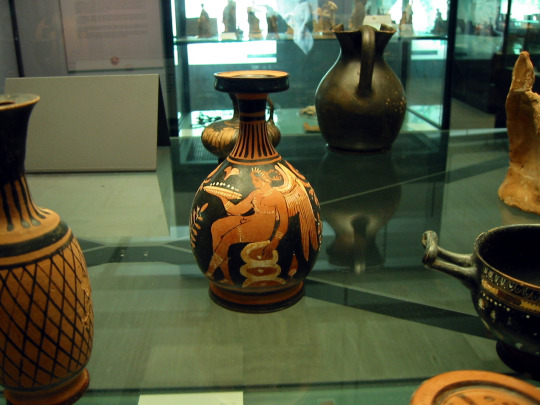
Greek Pottery
* Siris / Herakleia
* Museo Nazionale Della Siritide, Policoro
source: No machine-readable author provided. AlMare assumed (based on copyright claims)., Public domain, via Wikimedia Commons
47 notes
·
View notes